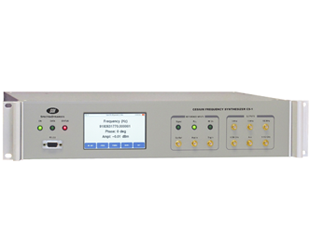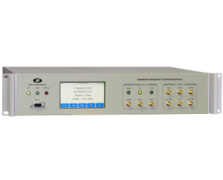The CS-1 Frequency Synthesizer is a high stability and high resolution signal source designed to be used in the implementation of a Cesium atomic clock. The CS-1 is provided as two separate modules, the Synthesizer Module and the DC power module. Both modules come in a 2U, 19 inch rack-mount enclosure. All synthesizer functions are accessed from the front panel or a RS232 interface. An external trigger input may be used to synchronize programmable events such as frequency sweeps, phase modulation and amplitude modulation with external events. The synthesizer is implemented with a flexible modular topology. Two ultra-low noise quartz oscillators are part of the multiplication chain from 5 MHz to 100 MHz. Buffered outputs are provided at the front panel for 5 MHz, 10 MHz and 100 MHz.
The 100 MHz signal is the highest frequency in the low frequency section of the synthesizer. This 100 MHz signal is distributed using a one input, four output isolation amplifier. One of these 100 MHz signal is used as the reference for a 9.2 GHz DRO. The output of the 9.2 GHz DRO is buffered and used to drive the LO port of a single-sideband mixer. The second 100 MHz signal is used to clock a DDS synthesizer module.
The DDS synthesizer generates an IF signal with 48 bit resolution and complete modulation capabilities. The DDS synthesizer output drives the IF port of the single-sideband mixer. The lower sideband of the mixer is selected as the output generating the 9.XXX GHz output signal. The amplitude of the 9.XXX GHz output is controlled with 12 bits of resolution and an internal relay may be used to turn off the RF signal.


